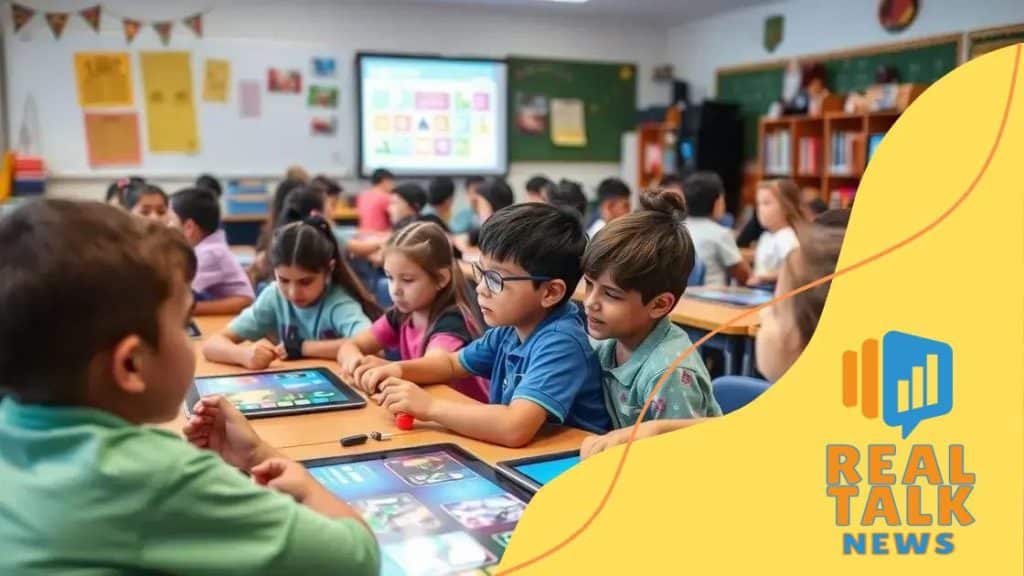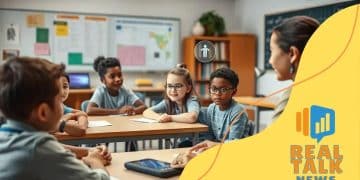How gamified learning is reshaping primary education

Gamified learning reshapes primary education by integrating game mechanics to boost student engagement, enhance knowledge retention, and foster collaboration among students while addressing challenges like access to technology and training.
How gamified learning is reshaping primary education raises intriguing questions about how we engage students. Imagine a classroom where learning feels more like play than work! In this article, we’ll explore how this approach is transforming learning experiences for children.
Understanding gamified learning
Understanding gamified learning begins with recognizing how traditional methods can be enhanced with game-like elements. This approach takes advantage of our natural love for play. By incorporating challenges, rewards, and feedback, educators can create a more engaging environment. It’s all about making learning feel like an adventure!
What is gamified learning?
Gamified learning blends educational content with game mechanics. It can involve points, levels, badges, and leaderboards to motivate students. This technique changes the way students interact with learning material, leading to better retention and engagement.
Why is it effective?
When students participate in gamified learning, they often exhibit greater enthusiasm. This occurs because:
- They feel motivated to complete tasks.
- Competition inspires them to perform better.
- Interactive elements make complex topics more understandable.
As a result, students who learn through gamified approaches tend to achieve higher academic performance while also enjoying the educational process.
Moreover, gamified learning promotes collaboration among peers. When students work together to solve challenges, they develop valuable teamwork skills. This cooperation enhances their overall classroom experience and fosters a sense of community.
Implementing gamified learning
To effectively implement gamified learning in the classroom, teachers should consider the following:
- Identify clear learning objectives.
- Select appropriate game mechanics that suit the content.
- Provide instant feedback to keep students informed of their progress.
By focusing on these aspects, educators can design meaningful learning experiences that resonate with students.
Key benefits of gamified education
The key benefits of gamified education are numerous and impactful. By integrating game elements into learning, educators can create a stimulating environment that fosters student engagement. One significant advantage is increased motivation. When students see learning as a game, they are more likely to participate actively.
Enhanced engagement
Students often show higher levels of engagement through gamified activities. In traditional learning settings, it’s common for learners to become bored or distracted. However, gamification transforms lessons into exciting challenges. This maintains their interest and encourages consistent participation.
Improved knowledge retention
Another key benefit is improved knowledge retention. Research shows that players remember information better when they learn it in a game context. This occurs because interactive experiences stimulate multiple senses, making learning more relatable. Therefore, complex subjects become easier to grasp when presented through gamified elements.
- Increased motivation leads to better participation.
- Interactive elements make learning memorable.
- Students can learn at their own pace.
Additionally, gamified education creates a safe space for experimentation. Students can fail without fear of negative consequences, encouraging them to take risks. This playful learning atmosphere contributes to a positive attitude towards schoolwork, where students feel they can be creative and innovative.
Fostering collaboration
Gamification also promotes collaboration among students. When learners work together to achieve a common goal, they develop important social skills. This teamwork can lead to better communication and problem-solving abilities. Engaging in group challenges or competitive games fosters a sense of community in the classroom.
Moreover, gamified education allows for instant feedback. Students receive immediate results about their performance, helping them to identify areas for improvement. This feedback loop is crucial in the learning process, enabling students to make adjustments and grow.
Successful examples in primary schools

Successful examples of gamified learning in primary schools demonstrate how effective this approach can be. Many educators have found innovative ways to incorporate game elements into their curriculum, leading to enhanced engagement and improved learning outcomes. One notable example is the use of digital platforms that turn everyday lessons into interactive adventures.
Using digital games in learning
Schools around the globe have begun to incorporate online games as part of their teaching strategies. For instance, math lessons transformed into games allow students to earn points as they solve problems. This healthy competition motivates them to learn more.
Project-based learning
Another successful approach is project-based gamification. Teachers assign projects where students must achieve specific goals, often in a team setting. These projects resemble quests in a game. Learners work together to complete tasks, overcoming obstacles as they develop critical skills.
- Promotes teamwork and collaboration.
- Encourages creative problem-solving.
- Increases participation in classroom activities.
Many educators highlight the benefits of incorporating rewards systems. Simple initiatives like earning badges or certificates for completing tasks can have a profound impact. This recognition fosters a sense of achievement and encourages students to strive for more.
Additionally, schools that integrate traditional subjects with game mechanics report increased student retention of material. For example, history lessons that use role-playing to reenact events allow students to connect emotionally with what they learn. This immersive experience makes history feel real and relevant.
Community involvement
Some schools involve the entire community in gamified education by organizing learning fairs. These events allow students to showcase their projects, which encourages family participation and support. Engaging parents creates a stronger connection between home and school.
Overall, these successful examples illustrate how gamified learning not only makes education more enjoyable but also effectively equips students with essential skills for their future.
Challenges to implementing gamification
Implementing gamification in education brings exciting opportunities, but it also comes with several challenges. Understanding these obstacles is essential for educators looking to create a successful gamified learning environment. One of the primary challenges is the initial resistance from both teachers and students. Some may feel uncertain about changing traditional teaching methods.
Technological barriers
Another significant obstacle is technology access. Not all schools have the necessary devices or software to implement gamified learning effectively. This limitation can create a gap between students who have access to technology and those who do not, leading to unequal learning opportunities.
Time constraints
Time is also an issue. Teachers often face tight schedules and curricular requirements. Integrating gamification can take extra planning and effort, which some educators might find challenging. This added workload can discourage teachers from adopting new methods, especially if they feel overwhelmed.
- Finding the right resources can be time-consuming.
- Balancing gamified activities with core curriculum requirements.
- Creating effective assessment methods for gamified learning.
Moreover, the need for continuous assessment presents another challenge. Teachers must develop ways to measure student progress in a gamified context. Traditional assessments might not align well with game mechanics, requiring new evaluation strategies.
Resistance to change can also stem from a lack of training. Teachers may feel unprepared to incorporate game elements into their lesson plans due to insufficient professional development. Without the necessary support, the transition to gamification can be daunting.
Maintaining student engagement
Lastly, maintaining student engagement over time is critical. Initially, students may be excited about gamified activities, but their interest can wane. Educators must continually innovate and refresh their approaches to keep students motivated.
Future trends in gamified learning
Future trends in gamified learning indicate an exciting evolution in educational practices. As technology advances, new possibilities for integrating gamification into the classroom environment will emerge. One significant trend is the increasing use of virtual and augmented reality. These technologies can create immersive learning experiences that transport students to different environments, enhancing their understanding of complex topics.
Artificial intelligence integration
An important trend is the integration of artificial intelligence (AI) into gamified learning platforms. AI can personalize the educational journey for each student. By adapting content based on performance and interests, learners can engage with materials that suit their needs, making learning more effective.
Collaborative learning spaces
Collaboration will continue to be a key focus in future gamified education. As schools increasingly promote teamwork, there will be an emphasis on designing activities that encourage students to work together. These collaborative projects can enhance problem-solving skills and build strong relationships among peers.
- Gamification will foster community engagement.
- Students will use teamwork to tackle challenges.
- Classroom dynamics will shift toward cooperative activities.
Another exciting trend is the gamification of assessments. Traditional exams may give way to game-based evaluations, where students demonstrate understanding through interactive challenges. This evolution can provide a more accurate representation of a student’s knowledge and skills.
Furthermore, as gamification gains traction in education, educators will prioritize professional development in this area. Training programs will help teachers learn how to implement gamified strategies effectively, fostering a more prepared teaching staff.
Integrating wellness and mindfulness
Lastly, there will be a growing trend to integrate wellness and mindfulness into gamified experiences. By incorporating elements that promote mental well-being, educators can create a balanced approach to learning. This focus not only addresses academic needs but also nurtures emotional and social development.
Overall, the future of gamified learning holds great promise for enhancing educational experiences. By embracing these trends, educators can create dynamic and engaging learning environments that inspire students to reach their full potential.
In conclusion, gamified learning offers a fresh and exciting approach to education. By incorporating game elements, educators can enhance student engagement and motivation. As technology continues to evolve, future trends promise even more innovative ways to integrate gamification into the classroom. Challenges, such as access to resources and training, need to be addressed, but the potential benefits are significant. Embracing these strategies can lead to a more interactive, collaborative, and enjoyable learning environment for students of all ages.
FAQ – Frequently Asked Questions about Gamified Learning
What is gamified learning?
Gamified learning is an educational approach that incorporates game-like elements, such as challenges and rewards, to enhance student engagement.
What are the benefits of gamified education?
The benefits include increased motivation, improved knowledge retention, and enhanced collaboration among students.
What challenges might educators face when implementing gamification?
Challenges include technology access, time constraints, and potential resistance from both teachers and students.
How can technology enhance gamified learning?
Technologies like virtual and augmented reality can create immersive experiences that make learning more interactive and enjoyable.





